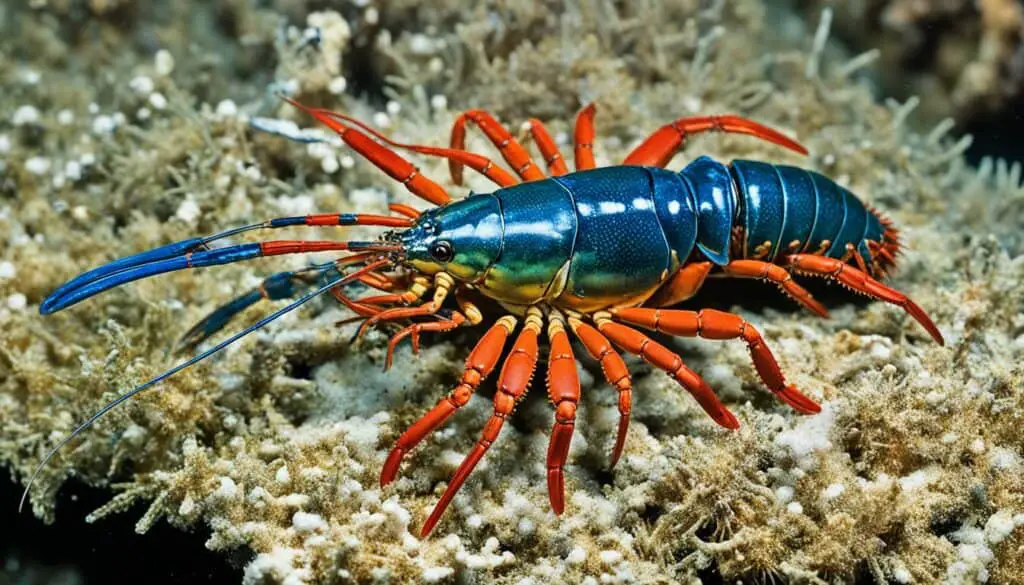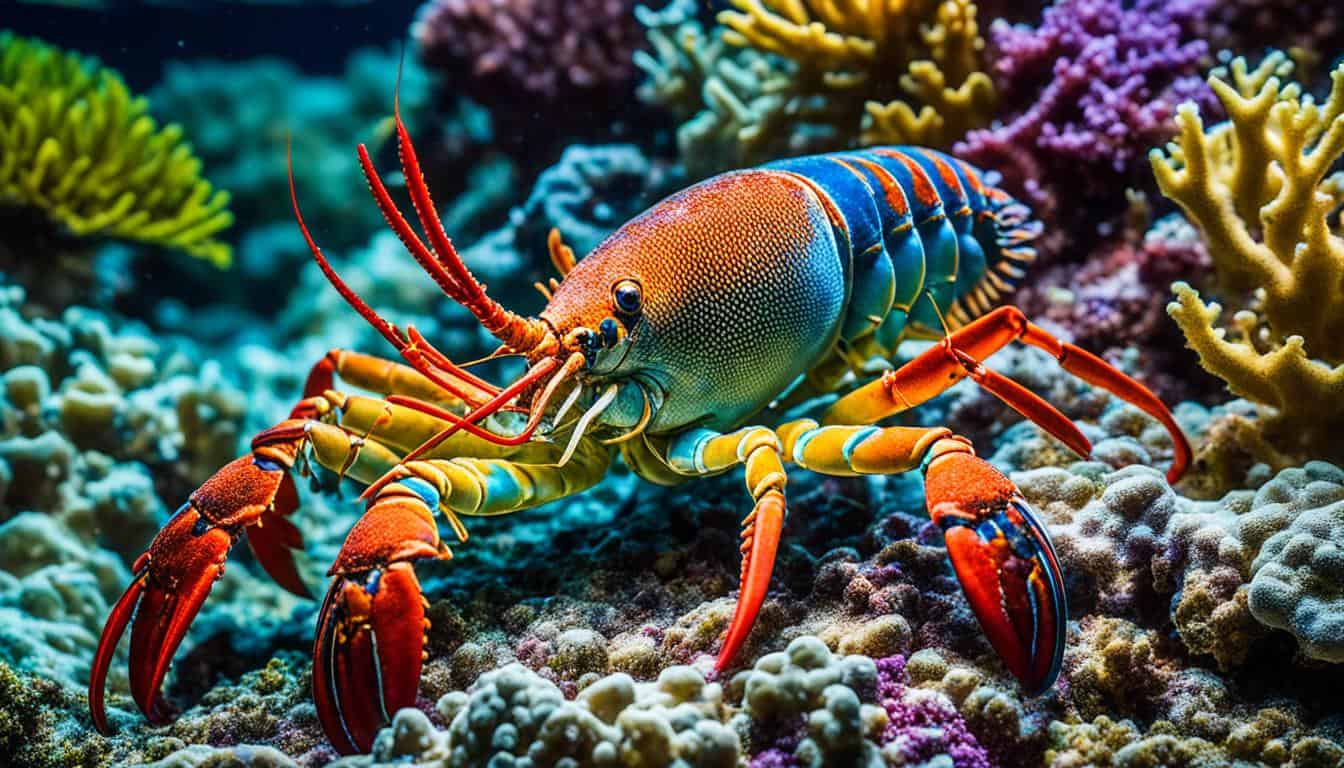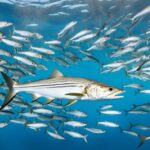Lobsters used to be seen as food for the less well-off. Now, they are a luxury enjoyed by many globally. There are about 75 different lobster species found in oceans worldwide. These lobsters can be split into cold water and warm water types, each living in unique places and having their own traits.
This article aims to give you a closer look at the various lobster species, where they live, and their role in food. It’s for anyone interested in seafood, whether you’re new to it or have been enjoying it for years. Learning about the different lobster species can deepen your love for this tasty treat.
Understanding Lobster Species
Lobster species fall into two main types: cold water and warm water lobsters. Each type has its own unique traits. These traits affect their environment, taste, and value in the market.
Cold water lobsters live in the North Atlantic and are famous for their hard shells and big claws. They thrive in cool waters, which makes them strong. Their firm texture and sweet taste make them a favorite in seafood spots.
Warm water lobsters, also called spiny or rock lobsters, live in warmer seas. They don’t have big claws but have long front parts that look like antennas. These lobsters have a soft shell and a milder taste, loved in many dishes.
Knowing about these lobster types is key for anyone into lobster classification. Their culinary importance shows in how they’re cooked and served. Cold water lobsters are often pricier because of their taste and texture. Warm water lobsters offer a unique dining experience.
Understanding lobster species can deepen your love for these seafood gems. Whether you like the firm meat of cold water lobsters or the soft taste of spiny lobsters, each type brings something special to the table.
Common Characteristics of Lobsters
Lobsters have many unique traits that make them stand out in the sea. They eat both animals and plants, which helps them grow and adds to their flavor. This varied diet makes each lobster species taste different.
When lobsters molt, they shed their old shell and grow a new one. The type of shell affects the meat’s texture and taste. Soft-shell lobsters are sweeter and tender, making them a favorite for food lovers.
Lobsters are also good for your health. They are high in protein and low in bad fats. This makes them a great choice for those looking for tasty, healthy food.
| Characteristic | Description |
|---|---|
| Diet | Omnivorous; includes fish, shellfish, and plant matter. |
| Molting | Process of shedding exoskeleton, leading to hard or soft shells. |
| Flavor Profile | Varies by species; soft shells are typically sweeter and more tender. |
| Nutritional Value | Rich in protein and low in saturated fat, beneficial for health. |
What are the different species of lobsters?
Lobsters live in both cold and warm waters. Knowing the difference between them makes us appreciate the variety of lobsters we can enjoy. It also deepens our understanding of seafood.
Cold Water Lobster Species
Cold water lobsters live in the North Atlantic’s icy waters. The Maine lobster is famous for its sweet taste and meaty texture. It’s often seen as a luxury food.
The Canadian lobster is also well-liked for its soft meat and reliable quality. European lobsters have a unique flavor and a harder shell. This affects how they are cooked and prepared.
Warm Water Lobster Species
Warm water lobsters live in warmer coastal areas. The Florida spiny lobster is known for its claws and spines. It tastes sweet and is usually less expensive than cold water lobsters.
The California spiny lobster is another type, loved for its flavor in many dishes. Caribbean lobsters are known for their bold taste and juicy meat. They’re a favorite in tropical dishes.
| Category | Species | Flavor Profile | Common Uses |
|---|---|---|---|
| Cold Water Lobster | Maine Lobster | Sweet, meaty | Boiling, grilling |
| Cold Water Lobster | Canadian Lobster | Tender, consistent | Steaming, baking |
| Cold Water Lobster | European Lobster | Rich, slightly briny | Soups, stews |
| Warm Water Lobster | Florida Spiny Lobster | Sweet, distinctive | Broiling, frying |
| Warm Water Lobster | California Spiny Lobster | Rich, unique | Tacos, seafood salads |
| Warm Water Lobster | Caribbean Lobster | Succulent, flavorful | Grilling, ceviche |
Popular Types of Cold Water Lobsters
Cold water lobsters are famous for their rich flavors and unique textures. Several varieties are popular, each with its own special taste and texture. Let’s look at three of the most well-known types, which are highly valued in the seafood market and by food lovers.
Maine Lobster
Maine lobster is often seen as the top lobster type. It’s known for its tender and flavorful meat. These lobsters come from Maine’s rocky coast and weigh 1 to 3 pounds. They are harvested from late spring to early fall.
When it’s in season, Maine lobster is in high demand, especially in fancy restaurants. People love its sweet, tender taste. It’s great for everything from boil dinners to fancy lobster rolls.
Canadian Lobster
Canadian lobsters are bigger and have denser meat than Maine lobsters. They come from the cold Atlantic waters. They’re perfect for steaming and baking because of their strong flavor.
Canadian lobster is loved for its good price and quality. It has a slightly firmer texture. This makes it great for pasta dishes and salads.
European Lobster
The European lobster is known for its unique taste and versatility in cooking. It’s found along Europe’s coasts and has a finer flavor that chefs love. It can be pricier than American lobsters but is worth it for its amazing taste.
This lobster type is used in many dishes, from bisque to grilled meals. It adds a special touch to any dish, making it a favorite in the cold water lobster market.

Popular Types of Warm Water Lobsters
Warm water lobsters are a tasty and popular seafood choice. The Florida spiny lobster, California spiny lobster, and Caribbean lobster are top picks. Each type has its own flavor and uses, fitting different tastes.
Florida Spiny Lobster
The Florida spiny lobster is known for its soft tail meat full of flavor. It’s a key ingredient in Florida dishes. Its texture is great for soaking up flavors, making it perfect for grilling, baking, or stewing.
California Spiny Lobster
The California spiny lobster is less common but highly prized. It’s known for its special taste and is seen as a treat. Its firm texture works well in many dishes, adding to its appeal.
Caribbean Lobster
The Caribbean lobster is known for its unique flavor and texture. It’s available in certain seasons, making it a favorite. Its sweet meat goes well with tropical flavors, enhancing salads, stir-fries, and pasta.
| Lobster Type | Flavor Profile | Notable Characteristics | Popular Cooking Methods |
|---|---|---|---|
| Florida Spiny Lobster | Rich and tender | Strong shell, meaty tail | Grilling, baking, stews |
| California Spiny Lobster | Unique and savory | Firm texture, sought after | Broiling, steaming, sautéing |
| Caribbean Lobster | Sweet and succulent | Colorful appearance, seasonal abundance | Grilling, stir-frying, in salads |
Diverse Lobster Species Around the World
Exploring the world of lobsters shows us the many types beyond what we usually see. The New Zealand lobster and the South African lobster stand out. They show us the beauty of marine life worldwide.
New Zealand Lobster
The New Zealand lobster, also called the Kina, is famous for its delicious taste and soft meat. It lives in New Zealand’s rocky seas. Chefs and food lovers love it for its versatility in cooking.
South African Lobster
The South African lobster lives in the warm waters off Africa’s southern coast. It’s a warm water lobster but has strong flavors. It’s important in South African food for its taste and cultural value.
| Lobster Species | Habitat | Culinary Uses | Market Price (per pound) |
|---|---|---|---|
| New Zealand Lobster | Rocky underwater environments | Grilled, steamed, in salads | $35 – $45 |
| South African Lobster | Coastal waters of South Africa | Grilled, roasted, in pastas | $25 – $30 |
Learning about these lobsters helps us appreciate their unique tastes and uses. Each lobster has its own story, showing us its home and its role in local food.
Lobster Classification and Cooking Styles
Knowing how to classify lobsters can change how you cook them. Hard shell and soft shell lobsters are two main types. Hard shell lobsters, like the Maine lobster, are denser and need special cooking to taste best. Soft shell lobsters have shed their shells and are more delicate.
Choosing the right cooking method depends on the lobster type. Here are some top lobster cooking styles:
- Boiling: Great for hard shell lobsters, boiling keeps them moist.
- Grilling: Works for both hard and soft shell lobsters, adding a smoky flavor.
- Baking: A flexible choice, baking is perfect for dishes like lobster mac and cheese.
Using these cooking methods offers many culinary experiences. Knowing about lobster species helps you pick the best cooking method for each type. This knowledge makes your meals more enjoyable and can impress your guests.
Lobster Species Facts You Should Know
Exploring the world of lobsters reveals some fascinating facts. For example, lobsters can live up to 50 years in the wild. Their lifespan depends on the species and their environment.
Lobsters live in different marine places. Cold water lobsters, like the Maine lobster, live on rocky ocean floors. Warm water lobsters, such as the Florida spiny lobster, live in shallow coastal areas. This variety makes them popular in seafood markets.
Knowing about lobster market trends is also key. Prices change with the seasons and global demand. The popularity of warm water lobsters shows how tastes in seafood are changing. Learning these facts can make you appreciate lobsters more and help you choose seafood wisely.
FAQ
What are the main types of lobsters?
Lobsters are divided into cold water and warm water species. Cold water lobsters include Maine, Canadian, and European types. Warm water lobsters are found in places like Florida, California, and the Caribbean.
What is the difference between cold water and warm water lobsters?
Cold water lobsters live in the North Atlantic and have hard shells and big claws. Warm water lobsters, or spiny lobsters, live in warmer places. They have smaller front parts that look like antennas.
Why are Maine lobsters considered special?
Maine lobsters are loved for their sweet taste and meaty texture. They are harvested carefully, which makes them stand out. Their flavor is unmatched.
What nutritional benefits do lobsters provide?
Lobsters are low in calories but high in protein and omega-3 fatty acids. They are also packed with vitamins and minerals. This makes them a great choice for a healthy meal.
How does the molting process affect lobster cooking?
The molting process changes the lobster’s shell hardness. This affects their taste and how they are cooked. Hard shell lobsters taste better and are more flavorful. Soft shell lobsters, which have molted recently, offer a different taste experience.
Are there unique lobster species outside the traditional markets?
Yes, there are unique lobsters like the New Zealand and South African types. The New Zealand lobster is known for its smooth meat and great taste. The South African lobster is known for its strong flavor.
How does lobster species classification influence cooking methods?
Different lobsters need different cooking methods. Hard shell lobsters are often boiled or grilled. Soft shell lobsters are best baked or cooked in other ways because they are more delicate.
What trends are currently seen in the lobster market?
The lobster market is seeing price changes and growing interest in certain types like Maine and spiny lobsters. Conservation efforts are also affecting the market as people focus more on sustainability.







